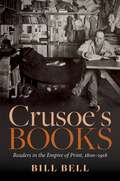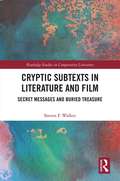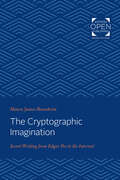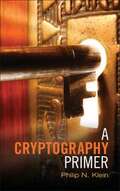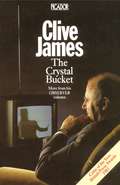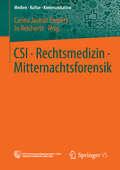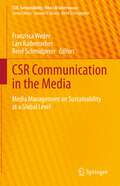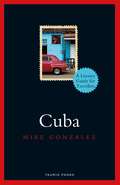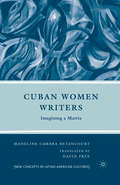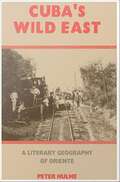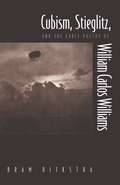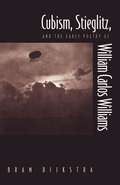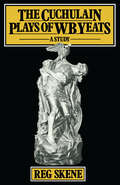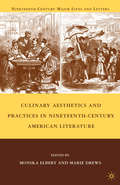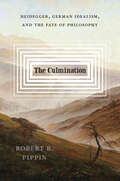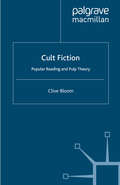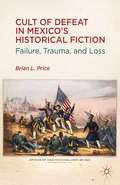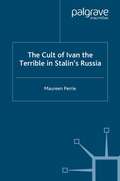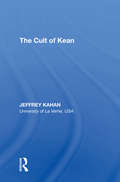- Table View
- List View
Crusoe's Books: Readers in the Empire of Print, 1800-1918
by Bill BellThis is a book about readers on the move in the age of Victorian empire. It examines the libraries and reading habits of five reading constituencies from the long nineteenth century: shipboard emigrants, Australian convicts, Scottish settlers, polar explorers, and troops in the First World War. What was the role of reading in extreme circumstances? How were new meanings made under strange skies? How was reading connected with mobile communities in an age of expansion? Uncovering a vast range of sources from the period, from diaries, periodicals, and literary culture, Bill Bell reveals some remarkable and unanticipated insights into the way that reading operated within and upon the British Empire for over a century.
Crusoe's Books: Readers in the Empire of Print, 1800-1918
by Bill BellThis is a book about readers on the move in the age of Victorian empire. It examines the libraries and reading habits of five reading constituencies from the long nineteenth century: shipboard emigrants, Australian convicts, Scottish settlers, polar explorers, and troops in the First World War. What was the role of reading in extreme circumstances? How were new meanings made under strange skies? How was reading connected with mobile communities in an age of expansion? Uncovering a vast range of sources from the period, from diaries, periodicals, and literary culture, Bill Bell reveals some remarkable and unanticipated insights into the way that reading operated within and upon the British Empire for over a century.
Cryptic Subtexts in Literature and Film: Secret Messages and Buried Treasure
by Steven F WalkerOne of the primary objectives of comparative literature is the study of the relationship of texts, also known as intertextuality, which is a means of contextualizing and analyzing the way literature grows and flourishes through inspiration and imitation, direct or indirect. When the inspiration and imitation is direct and obvious, the study of this rapport falls into the more restricted category of hypertextuality. What the author has labeled a cryptic subtext, however, is an extreme case of hypertextuality. It involves a series of allusions to another text that have been deliberately inserted by the author into the primary text as potential points of reference. This book takes a deep dive into a broad array of literature and film to explore these allusions and the hidden messages therein.
Cryptic Subtexts in Literature and Film: Secret Messages and Buried Treasure
by Steven F WalkerOne of the primary objectives of comparative literature is the study of the relationship of texts, also known as intertextuality, which is a means of contextualizing and analyzing the way literature grows and flourishes through inspiration and imitation, direct or indirect. When the inspiration and imitation is direct and obvious, the study of this rapport falls into the more restricted category of hypertextuality. What the author has labeled a cryptic subtext, however, is an extreme case of hypertextuality. It involves a series of allusions to another text that have been deliberately inserted by the author into the primary text as potential points of reference. This book takes a deep dive into a broad array of literature and film to explore these allusions and the hidden messages therein.
The Cryptographic Imagination: Secret Writing from Edgar Poe to the Internet (Parallax: Re-visions of Culture and Society)
by Shawn James RosenheimOriginally published in 1996. In The Cryptographic Imagination, Shawn Rosenheim uses the writings of Edgar Allan Poe to pose a set of questions pertaining to literary genre, cultural modernity, and technology. Rosenheim argues that Poe's cryptographic writing—his essays on cryptography and the short stories that grew out of them—requires that we rethink the relation of poststructural criticism to Poe's texts and, more generally, reconsider the relation of literature to communication. Cryptography serves not only as a template for the language, character, and themes of much of Poe's late fiction (including his creation, the detective story) but also as a "secret history" of literary modernity itself. "Both postwar fiction and literary criticism," the author writes, "are deeply indebted to the rise of cryptography in World War II." Still more surprising, in Rosenheim's view, Poe is not merely a source for such literary instances of cryptography as the codes in Conan Doyle's "The Dancing-Men" or in Jules Verne, but, through his effect on real cryptographers, Poe's writing influenced the outcome of World War II and the development of the Cold War. However unlikely such ideas sound, The Cryptographic Imagination offers compelling evidence that Poe's cryptographic writing clarifies one important avenue by which the twentieth century called itself into being. "The strength of Rosenheim's work extends to a revisionistic understanding of the entirety of literary history (as a repression of cryptography) and then, in a breathtaking shift of register, interlinks Poe's exercises in cryptography with the hyperreality of the CIA, the Cold War, and the Internet. What enables this extensive range of applications is the stipulated tension Rosenheim discerns in the relationship between the forms of the literary imagination and the condition of its mode of production. Cryptography, in this account, names the technology of literary production—the diacritical relationship between decoding and encoding—that the literary imagination dissimulates as hieroglyphics—the hermeneutic relationship between a sign and its content."—Donald E. Pease, Dartmouth College
The Crystal Bucket: Television Criticism From The Observer, 1976-79 (Picador Bks.)
by Clive JamesThe second instalment in Clive James’s TV criticism collection – The Crystal Bucket - earned him the title ‘Critic of the Year’ by the British Press Awards. Taking its title from Walter Raleigh’s The Passionate Man’s Pilgrimage and is dedicated to the poet Peter Porter.
CSI • Rechtsmedizin • Mitternachtsforensik (Medien • Kultur • Kommunikation)
by Carina Jasmin Englert Jo ReichertzDas Buch gibt einen Einblick in die Entwicklung eines Marktes in undum die deutsche Rechtsmedizin. Seit die Aufmerksamkeit der Medieneine Währung ist, konkurrieren auf diesem Markt unterschiedlicheAkteure miteinander. Diese Entwicklung geht auf Fernsehsendungen überVerbrechensaufklärung und Rechtsmedizin zurück und umfasst mehr alsden im US-amerikanischen Diskurs postulierten CSI-Effekt. Diesererklärt den Zusammenhang zwischen Fernsehsendungen wie _CSI: LasVegas_ und dem Verhalten von Geschworenen vor Gericht und demInteresse der Öffentlichkeit an Gerichtsmedizin. Dabei gerät aus demBlick, dass die Sendungen in ihren Darstellungen über die Wirkmachtrechtsmedizinischer Methoden nicht nur sehr unterschiedlich ausfallenkönnen, sondern dass auch die Folgen dieser medialen Darstellungenvielfältige gesellschaftliche Entwicklungen anstoßen.
CSR Communication in the Media: Media Management on Sustainability at a Global Level (CSR, Sustainability, Ethics & Governance)
by Franzisca Weder Lars Rademacher René SchmidpeterCorporate social responsibility (CSR) is an established management focus of today's companies and organizations of different types, scope and size. Communication practices on CSR and sustainability in the media industry, related theoretical concepts, and empirical foundations have not yet been sufficiently explored. This book focuses on a new normative framework of sustainability, bridging the established debate on public value with the current debate on social impact and the social license to operate in the media industry. With a variety of contributions from theory and practice, the book addresses the dual nature of media and media companies, which simultaneously produce economic and cultural goods and thus bear a "double responsibility": on the one hand, for the way they present reality, monitor and criticize economic and political developments, and bring ethical concerns to the public debate. On the other hand, they bear responsibility for their own activities as companies (license to operate). The book is therefore aimed at readers interested in the journalistic perspective and at executives in the media industry.
Cuba (Literary Guides for Travellers)
by Mike GonzalezCuba with its flamboyant style and rich culture, has provided the inspiration and setting for literature for decades. It has always been one of the most compelling places in the world, though perhaps never more so than now. Following Raúl Castro's resignation as President in 2018, the era of Castroism has come to an end, and the US-Cuba rapprochement has opened the country to a generation of Americans whose only previous exposure was through film and literature. The coming years will undoubtedly bring significant changes to a country that has in many ways been frozen in time.Cuba: A Literary Guide for Travellers takes the literary-minded traveller (either in person or in an armchair) on a vivid and illuminating journey, retracing the footsteps of writers and artists who have lived and worked in, or been inspired by, the history and landscape of Cuba. This literary guide challenges some firmly-held Western assumptions about the country, and shines a light on one of the richest and most deeply embedded literary cultures in the world.
Cuba (Literary Guides for Travellers)
by Mike GonzalezCuba has always been one of the most compelling places in the world, but perhaps never more so than now. With Raoul's promise to resign in 2018, the era of Castroism is all but over and the 2014 US-Cuba rapprochement has opened the country up for the first time to a generation of Americans whose only previous way in was through film and literature. The coming years will undoubtedly bring significant changes to a country that has in many ways been frozen in time. There is no better time for a Cuba literary guide, which challenges some firmly-held western assumptions about the country and shines a light on one of the richest and most deeply embedded literary cultures in the world. Cuba: A Literary Guide for Travellers takes the reader on a dynamic journey into the imaginations of iconic writers and artists in the heart of one of the most alluring countries in the world.
Cuban Women Writers: Imagining a Matria (New Directions in Latino American Cultures)
by M. BetancourtBetancourt examines women's writings in relation to language, power, sexuality and race in contemporary Cuba, analyzing the creation of alternative matria frameworks that enunciate a feminist/feminine perspective of the nationalist discourse.
Cuba’s Wild East: A Literary Geography of Oriente (American Tropics: Towards a Literary Geography #1)
by Peter HulmeCuba’s Wild East: A Literary Geography of Oriente recounts a literary history of modern Cuba that has four distinctive and interrelated characteristics. Oriented to the east of the island, it looks aslant at a Cuban national literature that has sometimes been indistinguishable from a history of Havana. Given the insurgent and revolutionary history of that eastern region, it recounts stories of rebellion, heroism, and sacrifice. Intimately related to places and sites which now belong to a national pantheon, its corpus—while including fiction and poetry—is frequently written as memoir and testimony. As a region of encounter, that corpus is itself resolutely mixed, featuring a significant proportion of writings by US journalists and novelists as well as by Cuban writers.
Cubism, Stieglitz, and the Early Poetry of William Carlos Williams
by Bram DijkstraPrevious studies of William Carlos Williams have tended to look only for the literary echoes in his verse. According to Bram Dijkstra, the new movements in the visual arts during the 1920s affected Williams's work as much as, if not more than, the new writing of the period. Dijkstra catches the excitement of this period of revolutionary art, reveals the interactions between writers and painters, and shows in particular the specific and general impact this world had on Williams's early writings.
Cubism, Stieglitz, and the Early Poetry of William Carlos Williams (PDF)
by Bram DijkstraPrevious studies of William Carlos Williams have tended to look only for the literary echoes in his verse. According to Bram Dijkstra, the new movements in the visual arts during the 1920s affected Williams's work as much as, if not more than, the new writing of the period. Dijkstra catches the excitement of this period of revolutionary art, reveals the interactions between writers and painters, and shows in particular the specific and general impact this world had on Williams's early writings.
Cuentos
by Charles PerraultUn gato que se las trae; Pulgarcito, un niño tan pequeño como valeroso; una Caperucita Roja que se deja engañar ingenuamente; la hermosa Cenicienta y sus envidiosas hermanastras... son los principales personajes cuyas aventuras y desventuras se narran en estos cuentos inmortales.
Culinary Aesthetics and Practices in Nineteenth-Century American Literature (Nineteenth-Century Major Lives and Letters)
by M. Drews M. ElbertCulinary Aesthetics and Practices in Nineteenth-Century American Literature examines the preponderance of food imagery in nineteenth-century literary texts. Contributors to this volume analyze the social, political, and cultural implications of scenes involving food and dining and illustrate how "aesthetic" notions of culinary preparation are often undercut by the actual practices of cooking and eating. As contributors interrogate the values and meanings behind culinary discourses, they complicate commonplace notions about American identity and question the power structure behind food production and consumption.
The Culmination: Heidegger, German Idealism, and the Fate of Philosophy
by Robert PippinA provocative reassessment of Heidegger’s critique of German Idealism from one of the tradition’s foremost interpreters. Heidegger claimed that Western philosophy ended—failed, even—in the German Idealist tradition. In The Culmination, Robert B. Pippin explores the ramifications of this charge through a masterful survey of Western philosophy, especially Heidegger’s critiques of Hegel and Kant. Pippin argues that Heidegger’s basic concern was to determine sources of meaning for human life, particularly those that had been obscured by Western philosophy’s attention to reason. The Culmination offers a new interpretation of Heidegger, German Idealism, and the fate of Western rationalism.
The Culmination: Heidegger, German Idealism, and the Fate of Philosophy
by Robert PippinA provocative reassessment of Heidegger’s critique of German Idealism from one of the tradition’s foremost interpreters. Heidegger claimed that Western philosophy ended—failed, even—in the German Idealist tradition. In The Culmination, Robert B. Pippin explores the ramifications of this charge through a masterful survey of Western philosophy, especially Heidegger’s critiques of Hegel and Kant. Pippin argues that Heidegger’s basic concern was to determine sources of meaning for human life, particularly those that had been obscured by Western philosophy’s attention to reason. The Culmination offers a new interpretation of Heidegger, German Idealism, and the fate of Western rationalism.
Cult Fiction: Popular Reading and Pulp Theory
by C. BloomHere is an exploration of pulp literature and pulp mentalities: an investigation into the nature and theory of the contemporary mind in art and in life. Here too, the violent, the sensational and the erotic signify different facets of the modern experience played out in the gaudy pages of kitsch literature. Clive Bloom offers the reader a chance to investigate the underworld of literary production and from it find a new set of co-ordinates for questions regarding publishing and reading practices in America and Britain, ideas of genre, problems related to commercial production, concerns regarding high and low culture, the canon and censorship, as well as a discussion of the rhetoric of current critical debate. Concentrating on remembered authors as well as many long disregarded or forgotten, Cult Fiction provides a theory of kitsch art that radically alters our perceptions of literature and literary values whilst providing a panorama of an almost forgotten history: the history of pulp.
Cult of Defeat in Mexico’s Historical Fiction: Failure, Trauma, and Loss
by B. PriceCult of Defeat in Mexico's Historical Fiction: Failure, Trauma, and Loss examines recent Mexican historical novels that highlight the mistakes of the nineteenth century for the purpose of responding to present crises.
The Cult of Ivan the Terrible in Stalin's Russia (Studies in Russian and East European History and Society)
by M. PerrieIvan IV, the sixteenth-century Russian tsar notorious for his reign of terror, became an unlikely national hero in the Soviet Union during the 1940s. This book traces the development of Ivan's positive image, placing it in the context of Stalin's campaign for patriotism. In addition to historians' images of Ivan, the author examines literary and artistic representations, including Sergei Eisenstein's famous film, banned for its depiction of the tsar which was interpreted as an allegorical criticism of Stalin.
The Cult of Kean
by Jeffrey KahanA Shakespearean actor who made his career on the public stage, whose sex life was known and discussed in Britain, America and France, Edmund Kean has inspired numerous writings, many biographies among them. But until now, no work has tackled the complicated and fascinating story of his literary appropriation, both in his own day and after his death. Dealing with the way a variety of canonical authors-including Byron, Coleridge, Keats, Dumas, Twain and Sartre-appropriated Kean through the centuries, The Cult of Kean traces a remarkable literary legacy. In each chapter Jeffrey Kahan discusses how many of history's greatest figures viewed Kean, and how these figures examined and discussed themselves in relation to-or projected themselves onto-a variety of constructions of the great actor. Kahan first explores the rise of Kean in light of rising democratic sympathies, then in light of Kean's equally autocratic dealings with playwrights, among them John Keats. He looks at Kean's sexual shenanigans at Drury Lane, exploring them in the wider social context of infidelity; and explores perceptions of Kean in America, during his 1820-1 and 1825-6 tours. The Cult of Kean cites many letters from Kean's mother and still others from his wife, none of which have been published previously. The study also features rare and interesting paintings of Kean, as well as depictions of how writers, actors and film makers continue to add to his remarkable literary legacy.
The Cult of Kean
by Jeffrey KahanA Shakespearean actor who made his career on the public stage, whose sex life was known and discussed in Britain, America and France, Edmund Kean has inspired numerous writings, many biographies among them. But until now, no work has tackled the complicated and fascinating story of his literary appropriation, both in his own day and after his death. Dealing with the way a variety of canonical authors-including Byron, Coleridge, Keats, Dumas, Twain and Sartre-appropriated Kean through the centuries, The Cult of Kean traces a remarkable literary legacy. In each chapter Jeffrey Kahan discusses how many of history's greatest figures viewed Kean, and how these figures examined and discussed themselves in relation to-or projected themselves onto-a variety of constructions of the great actor. Kahan first explores the rise of Kean in light of rising democratic sympathies, then in light of Kean's equally autocratic dealings with playwrights, among them John Keats. He looks at Kean's sexual shenanigans at Drury Lane, exploring them in the wider social context of infidelity; and explores perceptions of Kean in America, during his 1820-1 and 1825-6 tours. The Cult of Kean cites many letters from Kean's mother and still others from his wife, none of which have been published previously. The study also features rare and interesting paintings of Kean, as well as depictions of how writers, actors and film makers continue to add to his remarkable literary legacy.
